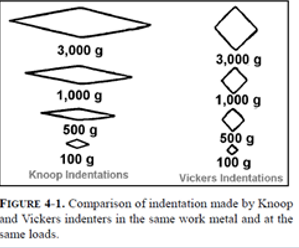
Looks like no one added any tags here yet for you.
What is the difference in the dent that the Vickers leaves on the component and the dent the Knoop leaves behind?

The Vickers indentation leaves a dent that is more of a square while the Knoop leaves a diamond-shaped indentation. Also, the diagonal of the Vickers indentation is about one-third of the total length of the Knoop indentation.
What is the name of the manual where you can find the differences between rivet types?
In the AC 43.13-1b, in Section 11 Hardware Identification Tables, table 7-10, Table of Rivets.
What are the characteristic of Screws?
Usually have a lower material strength, a looser thread fit, head shapes formed to engage a screwdriver, and the shank may be threaded along its entire length without a clearly defined grip.
What are the three basic screw types?
Structural Screws, Machine Screws, and Self-tapping Screws.
What are the three types of Bolts most often used in Aviation?
Most bolts used in Aviation are general-purpose, internal-wrenching, or close-tolerance AN, NAS, or MS bolts
How are bolts identified?
They can be identified by code markings on the bolt heads.
What is meant by Grip Length for Bolts and Screws?
It is the thickness of the material the fastener is designed to hold when two or more parts are being assembled.
What does the term "close tolerance" mean for the size of the hole of a bolt?
It means that the size of the hole just has enough space to fit without looseness.
What size do you use to determine to the torque value to be used? The head size or the shank size?
The Shank size
How often or when should you have a torque wrench calibrated?
At least once a year, or immediately after it has been abused or dropped.
What is the precaution to be exercised when installing internal wrenching bolts that are used in tension applications and why?
You must use a special heat-treated washer under the head to prevent the large radius of the shank from contacting only the sharp edge of the hole.
What are the two types of self-locking nuts used in aviation?
The all-metal type and the fiber or nylon type.
What is meant by "minimum prevailing torque value" when it comes to self-locking nuts?
It is a value that a self-locking nut should meet for it to be safe to use.
When should the threads of a bolt be lubricated?
When specified. When required by the Maintenance Manual
What is usually used in conjunction with a castellated nut to hold it in place?
A cotter pin
What are the three reasons why we use washers?
First is s to provide a smooth bearing surface. Second, act as a shim to obtain the proper grip length. Third, to position castellated nuts in relation to drilled cotter pin holes in bolts.
Where would you expect to use an AN950 or NA955 part number washer?
They are used in special applications where the bolt is installed at an angle to the surface or when perfect alignment with the surface is required.
When it comes to the securing of A/C components what is the definition of safe tying?
Securing by various means any nut, bolt, turnbuckle etc., on the aircraft so that vibration will not cause it to loosen during operation.
What is the difference between safety wiring and security seal wiring?
The difference between them is that safety wiring is used to prevent nuts, bolts, turnbuckles etc. from loosening while the security seal wiring is used to secure and seal items to prevent unauthorized access or tampering.
Do drilled head bolts and screws require lock wiring when fitted with a self-locking nut?
No, it is not needed.
With lock wire, how many twists per inch is recommended?
6 to 8 twist per inch.
When installing cotter (split) pins, what should you do to prevent injury after the pin has been installed?
To prevent injury during and after pin installation, the end of the cotter pin can be rolled and tucked.
What are the 10 questions you need to ask yourself prior to a task?
Do I have the knowledge to perform the task?
Do I have the technical data to perform the task?
Have I performed the task previously?
Do I have the proper tools and equipment to perform the task?
Have I had the proper training to support the job task?
Am I mentally prepared to perform the job task?
Am I physically prepared to perform the task?
Have I taken the safety precautions to perform the task?
Do I have the resources available to perform the task?
Have I researched the FAR's to ensure compliance?
What are the 10 questions you need to ask yourself at the completion of a task?
Did I perform the job task to the best of my abilities?
Was the job task performed to be equal to the original?
Was the job task performed in accordance with appropriate data?
Did I use all the methods, techniques, and practices acceptable to industry?
Did I perform the job task without pressure, stress, and distractions?
Did I reinspect my work or have someone inspect my work before returning to service?
Did I make the proper record entries for the work performed?
Did I perform the operational checks after the work was completed?
Am I willing to sign on the bottom line for the work performed?
Am I willing to fly in the aircraft once it is approved for the return to service?
What does it mean if you answer no to any of the questions above?
It means that the aircraft should not be returned to service.